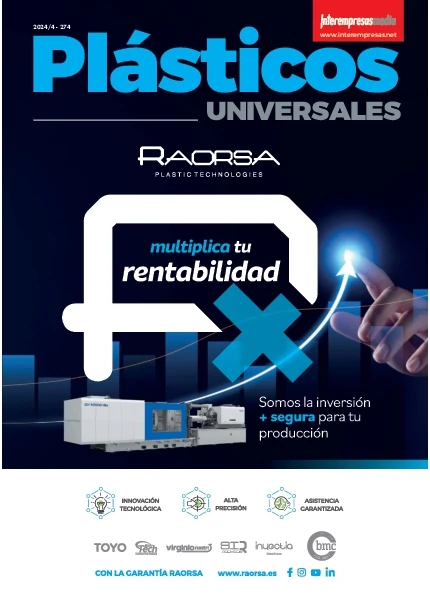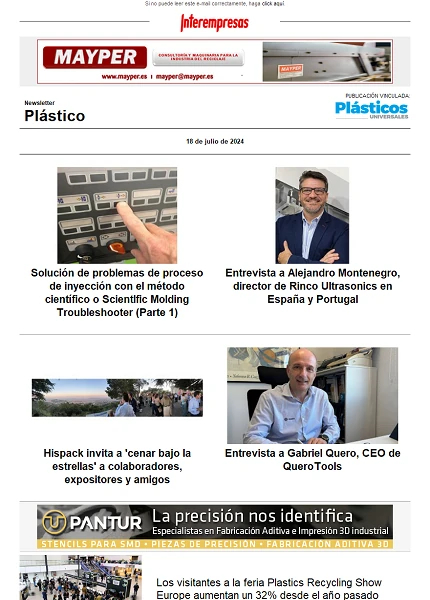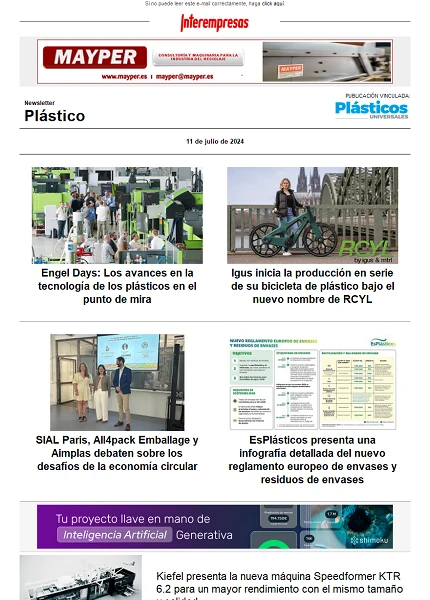Air conditioning Radiant and boiler of condensation: an efficient tandem
Iván Brown, president Group Air conditioning Radiant of

Conventional boiler and system of radiators
In the case to combine a conventional boiler with a system of radiators, appreciate that it is necessary to heat the water that circulates by the radiators until an approximate temperature of 65-70 °C, with the end that the heat issued by the radiator in an extreme of the room, can heat the opposite extreme of the same.
To attain that the water circulante reach this temperature, is necessary to heat it in the boiler, by means of the combustion of a fuel. The heat produced transmits of two ways that are the radiation of the flame, owed the high temperature of the same and by driving-convection losing a part of said heat through the smokes that generate in the combustion and through the carcasa of said boiler.
But these will not be the only causes by which produce energetic losses but in the emisor will produce also the loss of heat because of the big difference of existent temperature between the outside and the emisores situated usually below or beside the ventanales to avoid the effect window. With this achieves increase the feeling of comfort in the vicinities of the same but by the expense of that a big part of the heat lose through the enclosures.
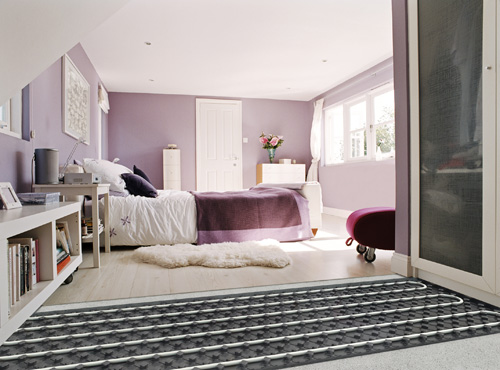
Boiler of condensation and radiant floor
Said that in the case of the conventional boilers, transmits the heat by radiation of the flame and by driving-convection. In the case of the boilers of condensation exists a third way that takes place also by driving-convection and that has to to the aprovechamiento of the latent heat content in the pertinent smokes of the combustion and that frees in the condensation of the steam of water generated during the combustion, being transferred to the water of the boiler.
According to his behaviour in front of the condensations (Royal decree 275/1995 trasposición of the European Directive 92/42/CEE, the boilers classify eat:

The boiler of condensation takes advantage of the latent heat that give off the smokes of the combustion when happening of been gas to liquid. It is now when it earns felt the combination of the boiler of condensation with the systems of radiant floor since these systems characterise for working with water heated to a next temperature to the 45 °C degrees and that it is easily alcanzable taking advantage of the heat of condensation.
This difference of temperature in comparison with the systems of radiators, is sufficient to turn into them the systems that better adjust to the optimum broadcast of heat of the human body by radiation, convection, transmission and evaporation. This is due to that the feeling of temperature of the people does not correspond to the temperature of air, but equivale to the temperature of comfort, designated also operative temperature.
Of practical form, the operative temperature in the interior of a house equivale to the value average between the temperature of the air and the radiant temperature average of the inner surfaces of the room (floor, ceiling, walls, doors, windows, etc.).
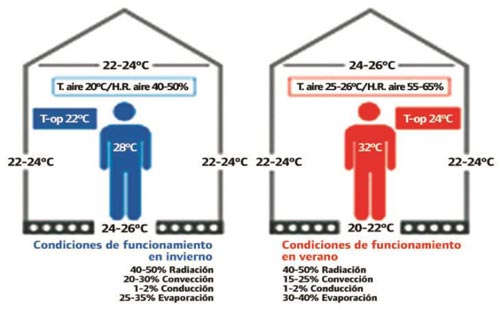
That is to say, if in winter wish to keep a temperature of comfort determined, can diminish the temperature of the air and increase the radiant temperature average of the room, which will be possible taking into account the basic principle of operation of the system of radiant floor.
The air conditioning radiant (floor, ceiling or wall) contributes eficientemente to the energetic saving, to the reduction of broadcasts of CO2, to the improvement of the energetic qualification and to the reduction of costs for the user
Basic principle of operation of the system of radiant floor
Promoting water to 40-45 °C in way heating, through a network of circuits that install on a signpost térmicamente insulator that prevents that the heat of the water circulante transmit to the forged of the building, attains that a losa of mortar that recubre the pipes, accumulate the heat and that thanks to his thermal sensors inertia can conserve the thermal sensors power received and go freeing it progressively. In this way it diminishes the need of contribution of air conditioning.
Said heat will be transmitted to the final paving that to his time, issues this power to the walls and ceiling of the room by means of radiation and in lower degree natural convection.
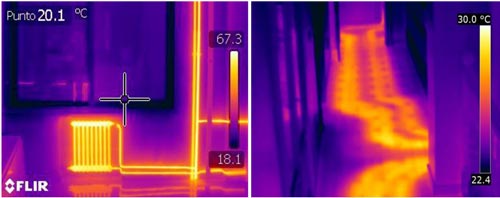
Of this way will give the necessary conditions so that the people can maintain a balance thermal sensors, without the intervention of the system of termo-own regulation and reach a state of thermal sensors comfort to a temperature of 21-22 °C, with a lower consumption of power and reducing the losses of heat through the enclosures. This is possible for being the temperature of the air in the interior of the house, nearer to the one of the outside.
Later the water of return will return to the boiler with a next temperature to the 35 °C (underneath of the temperature of dew of the gases of combustion) to be heated again, which favours the improvement of the performance of the same until reaching 108% roughly.
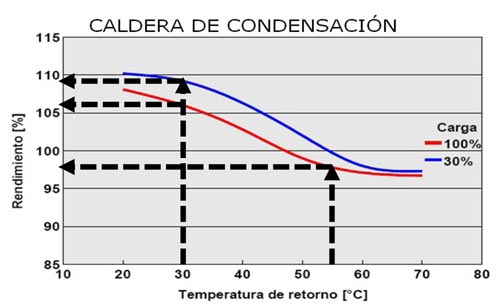
Comparative study between radiators of aluminium and system of radiant floor
The department of Energetic Engineering of the Upper Technical School of Industrial Engineers of the National University of Education to Distance has realizar diverse studies in which it compares a same installation with radiators of aluminium and with radiant floor.
The study realizar no only from the point of view of the energetic consumption, but also taking into account the net current value (GO) of both systems.
To continuation and of form resumida presents the study of two installations:
- Boiler of condensation and radiators of aluminium.
- Boiler of condensation and radiant floor.
The data of the building of study are the following:
Data of the building
- Type of use: Houses in height
- Zone to Calefactar: 660 m2 of houses
- Location: Madrid, Stir
Author of the study
- Dr. Engineer Santiago Aroca Lastra
- Upper Technical School of Industrial Engineering UNED
Method of calculation
- PowerPlus: Simulation and energetic analysis
- Lider: Fulfillment of the HAVE-1
- Fulfillment RITE 2007
Climatological data
- Madrid
- Latitude: 40,5º N / Length: 3,5º And
- Altitude: 595 m
- Level percentil of 99%: -4,9 °C
- Level percentil of 97,5%: -3,7 °C
- relative Humidity: 85%
- daily half Swing: 7,9 °C
The cases analysed indicate in the following table. In all the cases used a boiler of central condensation Baxi Rock model Power HT-45/F.

In all the cases, considered similar thermal sensors loads and the same operative temperature.
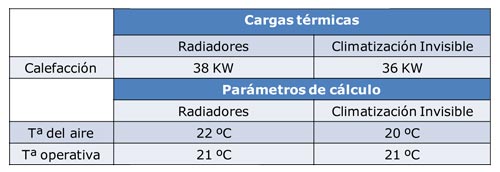
Dimensionado Of the installations in function of the temperature of impulsión, return and of the air.

The radiators used for the study are mark Baxi Rock model JET 80.
Main data:


The results of the study of the 5 cases analysed detail in the following table:
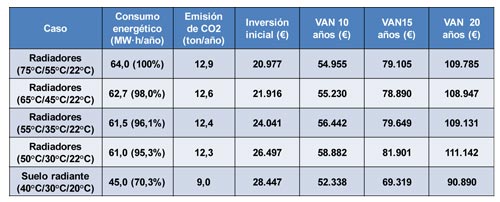
Of these results gives off the best environingingmental behaviour of the systems of air conditioning radiant in front of systems of conventional radiators. So much in annual energetic consumption as in broadcasts of CO2 to the atmosphere, the systems of air conditioning radiant are 30% inferior.
Since the energetic efficiency of the boiler increases slightly when diminishing the temperature of return, the annual energetic consumption of the systems of radiators to low temperature also diminishes slightly although the number of elements of radiator that will require increases between 1,5 and 3,7 times.
Is likewise to stand out that although the initial investment of the heating by radiant floor is slightly upper to the cases in that they employ radiators of aluminium, his net current value is inferior to the of the remaining installations considered to the cape of only eight years. During at least two thirds of the period of useful life of the installation the heating by radiant floor results economically beneficial.
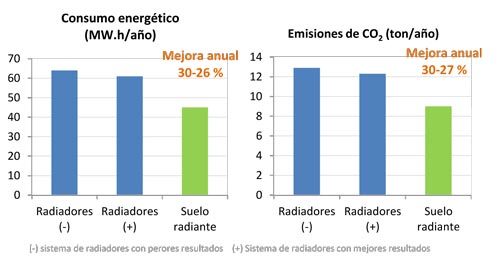
With the utilisation of a heating by radiant floor, taking a period of reference of 25 years:
- Save 475 MWh of energetic consumption with the utilisation of a heating by radiant floor (19 MWh annual saving).
- Avoids the broadcast of 97,5 tonnes of CO2 (aprox. 4 tonnes less every year).
Other entities and independent organisms have carried out similar studies of which extract the following conclusions:
Study Precost&And
The placing of a system of heating by radiant floor, in equality of conditions of design and envolvente, supposes an improvement in the energetic qualification of the building.
Study ETSII
Of the comparative study realizar for a building for residential use deprived between a conventional system by means of radiators/splits only cold in front of an alternative system of air conditioning by means of radiant floor and refrescante arrives to the conclusion that the radiant system/refrescante offers distinct improvements regarding the conventional system of radiators/splits:
- Lower energetic consumptions on a long-term basis.
- Total elimination of the noise in the busy zone.
- Reduction of the maintenance when deleting the need of replacement of filters in the inner units, recarga of gas refrigerante, etc.
- Lower annual broadcasts of CO2 to the atmosphere.
The economic study (for places in the interior of the Spanish geography, as it is the case of Madrid) indicates that the system of air conditioning radiant floor/refrescante achieves a profitability from the first moment of his period of exploitation. In the case of coastal places where requires a system of control of humidity, the periods of return of the investment are more acceptable for the useful life of the installation.
Study Enervalia
The installation of systems of air conditioning by ceiling refrescante in offices in front of ceilings refrescantes by air and fan coils presents several advantages:
- The necessary power of the equipment of generation of cold sees reduced in 32%.
- The energetic consumption reduces 37,7% regarding the consumption of the conventional system.
- The reduction of the energetic consumption no only produces economic savings but also environingingmental, reducing in 28% the broadcasts of CO2 to the atmosphere regarding the broadcasts of the system of air conditioning conventional,
- do not occupy space in the offices since they go installed on the false ceiling and do not produce noises.
- The distribution of the temperatures (air and operative) is much more homogénea by means of the radiant system that with the conventional and achieves an area of greater comfort. With the conventional system create zones to different temperatures under the zones of influence of the diffusers of air that can create disconformidad in the occupants.
Conclusions
The combination of a boiler of condensation and a system of radiant floor contributes:
- Improves the energetic qualification of the building or house.
- Reduction of the bill in the cost of fuel (more than 200 €/year).
- Improves of the feeling of comfort in the house.
- Uniform distribution of the heat in the house.
- Improves in the thermal sensors isolation of the house.
- Improves of the performances of the boiler of condensation, reaching until 108%.
- Reduction of the losses of power in the combustion of the boiler.
- Reduction of the losses of power through the enclosures of the house.
- Reduction of the broadcasts of NOx until 20-30 mg/kWh.
- The radiant floor is the best alternative, even in front of radiators of aluminium.
References
RD 275/1995: Royal decree 275/1995 by which dictates the disposals of application of the Directive of the Council of the European Communities 92/42/CEE, relative to the requirements of performance for the new boilers of hot water fed with liquid or gaseous fuels, modified by the Directive 93/68/CEE of the Council.
Study UNED: 'comparative Study of the energetic consumptions of a system of heating with radiators of aluminium in front of a system of heating by radiant floor'. Upper technical school of industrial engineers. Department of energetic Engineering. National university of education to distance.
Study Precost&And: 'Evaluation of the constructive costs and energetic consumptions derived of the energetic qualification of houses', Polytechnical University of Madrid. Department of Construction and Rural Roads.
Study ETSII: 'comparative Study of the system of air conditioning invisible Uponor in front of a conventional system for a block of subject houses to the climatologies of Madrid and Barcelona CC-2009/1516'. Upper technical school of industrial engineers. Polytechnical university of Madrid.
Study Enervalia: 'energetic Simulation and CFD of systems of air conditioning conventional and air conditioning invisible Uponor'. Enervalia (Skilled engineering in energetic quality consultancy).
Notices: the comparative studies referenciados in this document can consult in
On Asetub
The



